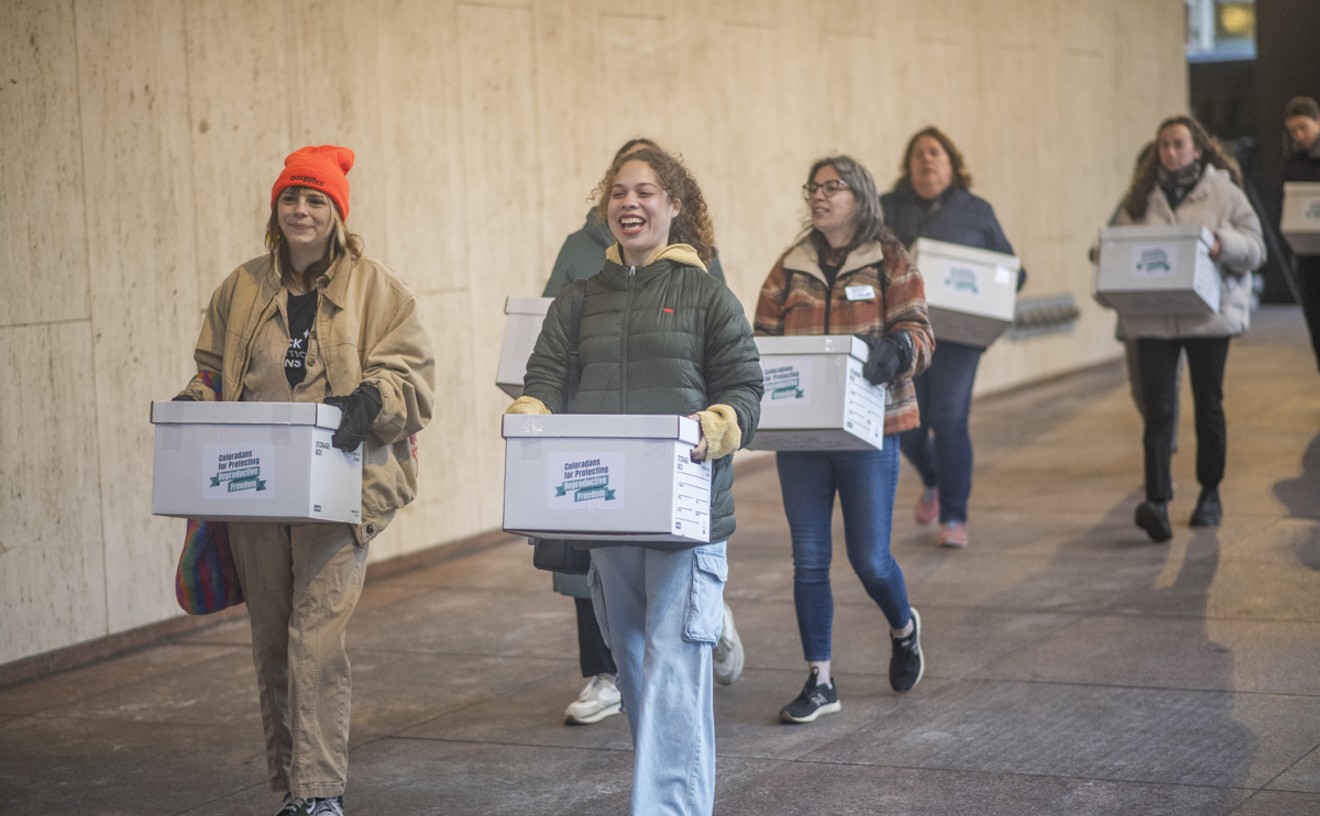The way Raymond lives, washing dishes takes some time, and he often lets them pile up for days. Pushing aside the cloth that covers the doorway, he walks outside his one-story stone house and goes around to the back. There he ladles water from the barrels in which he collects and stores rain that has run off the metal roof. The first barrelful following a storm is usually browned by the dust that accumulates on the roof between cloudbursts; he uses it strictly for washing. But after that, the water is clean and sweet and good for drinking.
Inside again, Raymond heats the water on his white ceramic stove. It is fired by propane, since electricity hasn't made its way out to his place. Nor, for that matter, have paved roads, phone lines, gas lines or sewer lines; here the mail comes three times a week from a post office twenty miles away. Once the water is hot, he begins washing.
"I had a dish towel on my shoulder," he remembers. "I was happy to see the helicopter. I said to myself, 'We got some buyers for the ranch.'"
The 8,000-acre spread was homesteaded by Gutierrez's father nearly a century ago. The property lies on the cusp of a geologic transition point in southeast Colorado, where the dusty dry-wheat farms of the east-central plains disappear and the landscape begins to be dominated by red and white chalky bluffs, gnarled pinon and thick grasslands fed by the Purgatoire and Two Buttes rivers.
The whirlybird skimmed over the house, hovering close, and then banked away. "They flew around a few times, down to the ranch where I was born"--on May 24, 1916--"then back here to my place," Raymond recalls. "I waved at them, and they waved at me, and then they landed over by my wood stack."
Raymond's stacks really aren't stacks, but tangled hives of cut branches and slash. The house's only source of heat is the cast-iron stove in the living room, so gathering wood is a year-round chore. For nearly a mile circumference surrounding the house, Raymond has prepared and left heaps of the fuel. Only he knows where they are.
Curious and a little excited, he walked out of the house to meet the visitors. Outside of hunting season, guests are extremely uncommon in the area, which is called Villegreen. "You get a strange car in that area and people notice it," says Las Animas County sheriff's sergeant Robert Rose, who works out of a substation a half-hour's drive away, in Kim. Established in 1916 by a homesteader who named it after his favorite Rudyard Kipling book, the town's heyday was in the 1920s, when it supported nearly thirty businesses. But during the droughts of the late 1930s, Kim began to decline. Today, with a population of 84, seven businesses, the old community center built under the Works Progress Administration and the post office, it is what people here mean when they refer to "town."
Except for his distant younger cousin, who brings him groceries, Raymond doesn't usually see or talk to anyone. When the temperature is searing, as it often is in the summer, he fills the old bathtub outside his house with water and lies in it naked for hours without fear of discovery. (He also cuts the crotch out of new pants to make it simpler to pee--an accommodation to his 83-year-old bladder.) He is often alone for days or weeks at a time, a circumstance he has gotten used to ever since his father ordered him off the family ranch and up to the isolated house on top of the hill nearly a half-century ago.
Raymond is friendly, even generous, to those he does encounter, however. "Stop by anytime you want to hear some more lies," he will say. A couple of years ago, a two-man film crew from New York City was making a documentary about old post offices when their car broke down near Raymond's house. He told them they could spend the night at his place or take his truck into La Junta, an hour-and-a-half drive. (What use is a vehicle to a man who hasn't had a driver's license since 1954?) "Come back when you can," he told them when they pulled away. They returned the following day and thanked him, chatted for a few hours and then left.
After the helicopter settled into the grass, Raymond watched the men step down from the cockpit. "Two guys got out, and got down like this"--here Raymond hunches his shoulder and ducks imaginary blades--"so they wouldn't get hit. I said, 'How do you like the place?' They said, 'Oh, it's a wonderful place. But we've come to ask your permission to look down the canyon.' They said they had found some--what did they call it--'mary-jew-wanna.' They couldn't say it the right way: 'mari-whana.'
"Well," Raymond continues, "people come down here to hunt, look for arrowheads, picnic, and I don't deny them. Why would I? But they had suits on, guns, walkie-talkies. They said, 'If you don't let us look, we'll just get a court order.'
"I said, 'Go ahead. But you just gotta follow my rules like everyone else. Don't roll rocks. Don't erode the bluffs. Watch out for snakes.'"
Later, after they charged Raymond Gutierrez with cultivating one of the area's largest marijuana crops in recent memory, the sheriff's deputies returned to confiscate his guns, and he made them rainwater coffee on the old ceramic stove.
Eugene "Dugan" Eddy repairs and services office machines for the copier store in La Junta. His territory sprawls in a vast triangle across the southeast corner of Colorado, between the agricultural centers of La Junta, Lamar and Springfield. Often, he makes these business trips with a partner so they can trade off sleeping as they follow the straight roads bisecting the plains.
Dugan has two children, both grown now. One day about five years ago, his son, the older of the two, was hunting in the empty hills south of La Junta. "He came in from the trip out there, and he told me, 'I was out in the country hunting deer and I met this old man, a hermit,'" Dugan recalls. "And as he described him--a long white beard like ZZ Top, living with no electricity or water--I said, 'That's gotta be Raymond. He's our cousin.'"
Dugan had faint memories of Raymond. He remembered when, as a ten-year-old child, he would see Raymond come into La Junta from the ranch to sell milk and cheese he had produced from his cows. His beard was down to his waist then (although when some of the girls told him it looked funny, he quickly cut it shorter).
His son's chance meeting with a lost relative goosed Dugan's curiosity, and eventually it inspired him to reacquaint himself with Raymond. Since then he has become part caretaker, part friend to his elderly cousin. He tries to get out to the isolated house once a week with groceries (a large portion of the bags are filled with doughnuts and soda pop), but that isn't always possible, particularly in winter, when the dirt roads become thick and slippery with mud. After big storms, it can take most of the day to make the trip; a marooned driver can wait for hours before he is discovered by another motorist.
Some people who remember him think of Raymond as crazy, and this had influenced Dugan's opinion. When he first started making the trips, he would drop off the food and drive back as fast as he could get away. But as time has passed, Dugan has grown fond of Raymond. Now he finds himself hanging around his cousin's place for hours, even overnight. "My wife thinks I spend too much time out there," he says. "I guess I'm supposed to be at home."
Raymond's house is not difficult to find, just far away from anyplace that appears on a map. Twenty-eight miles outside of La Junta, right before Otero County ends and Las Animas County begins, a dirt road peels off the new pavement of Route 109. It heads west, and then due south, cutting between Smith Canyon to the east and Plum Creek on the west. Depending on the direction in which he decided to strike out, a person who wandered off the road here could stray in a straight line for up to sixty miles before he encountered another road.
Dugan has lived in the area all of his life, and he knows the topography by its stories. Fifteen miles along the dirt road, he points toward a pair of crumbling adobe buildings to the west. "Those used to be what they call the Penitent Church," he says. "There's still a church going up in the hills, but the people aren't as cruel to themselves as they used to be. They used to whip themselves and pour salt into the wounds. And during the Lenten season, they'd carry crosses up to the top of the buttes.
"I could never do that," he adds, shaking his head. "Too painful. Life already has too much pain."
The less an area is populated, the bigger the stories seem to be, particularly those with no satisfying endings. They stand out like tall features in a flat landscape. For example, about ten years ago, Dugan says, nodding generally to the west, a small plane landed on one of the buttes. But it had just rained, and the wheels became stuck in the mud. The plane was filled with sticky bales of marijuana. No pilot was ever found.
Raymond came from a family of seven children--five brothers and two sisters. One of them is dead, one is in a nursing home, one is in La Junta and one lives in Denver, Dugan says. Three of the brothers, including Raymond, live on the ranch assembled by his father--he was known as Big Raymond--during the fifty years he worked the scrubby grazing land. Today the brothers are Raymond's nearest neighbors; the closest one lives about six miles away.
Big Raymond's legacy was to bind his family together with his land--regardless, it turned out, of how they felt about each other. When he died, in 1968, he willed the spread to his children, dividing it equally among them. But rather than leave a particular piece to each, he left it to them "in common": Each of his children owns everything and nothing. No one can make a move without all of the others' approval. Big Raymond further enmeshed his descendants when he left orders that the ranch was to be sold all at once or not at all.
Recently, the remaining members of the Gutierrez family decided to put the family spread on the market. The asking price is about $1 million. The abundant promise of the sale has blended with the bittersweet recognition that they are abandoning the family's heritage, and the negotiating over terms with prospective buyers and each other has wound tensions tight between the brothers. "The family is feuding because we can't decide what to do with this land," Raymond says. "You know how families are."
Dugan suspects they were never close to begin with. "They don't talk to each other very much, and they don't help each other at all," he says. "They're afraid each is getting more than the other."
When word spread that Raymond appeared to be farming marijuana, the span between him and his neighbors--that is to say, mostly his family--widened even more. "If Raymond says something, he's the only one out there. There's no witnesses, so it's just his word," says Dugan. "People tend not to believe him. Especially his brothers. So I believe him."
"Everybody," Dugan concludes, "is a suspect out here."
"Once," says Pueblo lawyer Darol Biddle, "I asked Dugan, 'What does Raymond do out there?' And he said, 'He thinks a lot.'"
The inside of Raymond's house is plastered with newspapers, old and yellow. Some were printed decades ago. There are three rooms. The living area has a dirty potbellied wood stove in the center. A table next to it is littered with paper and lit by a kerosene lamp; a clothesline is looped over it. Against one wall is a lumpy couch with several cushions missing.
The bathroom, which doubles as the bedroom, contains a pail--the toilet--and a large metal washtub, which Raymond uses for bathing and washing his clothes. In between loads he leaves his dirty clothes on the floor. The clean ones are kept in bags, to keep off the dust.
On one wall in the living area hangs a charcoal drawing of Jesus. Below, propped upright on a shelf, are three more charcoal portraits. One is of Dugan's daughter. Another is of a young girl, a distant niece. The picture on the left is of an older, strikingly beautiful woman. She has almond-shaped eyes and a broad, open face. The drawing is dated 1950.
"That's a girl I used to go with when I was a young fellow, in 1937," says Raymond. "Rosabelle. I thought maybe I'd marry her. But she kind of double-crossed me. I heard she moved to Texas, went to the loco house, went crazy. But it wasn't my fault."
Raymond's sketch pad has other illustrations. "I draw to keep my mind busy," he says. "So I won't go crazy." In the evening, after he has taken his mile walk up and back on the dirt road, Raymond will open the door to the stove. He selects a small piece of blackened fuel and begins to sketch.
There are a couple of nudes--a local judge's daughter whom Raymond has imagined naked--a forest scene with a deer slipping through the trees in front of a hunter, and a three-page series that repeats the same scene: Raymond is returning home in the evening from cutting wood, and the setting sun is to his rear, out of the picture. His shadow falls in front of him toward the house, which glows from the slanting light.
He has been contemplating the view for nearly half a century. "I moved out of the family house in the '50s," he says. "My brothers had got married, and they didn't want me around. One day me and Dad was driving to town, and he told me to move up on the hill. I didn't want to oppose him. He said, 'I'll come up and live there with you for a while.' The house was a little cleaner than it is now...
"Dad gave me this place in a verbal manner," he continues. "He said if I did good, he'd give me the place to keep. He gave me some cows, about twenty head of heifers. He said, 'You go up there. I need somebody to watch the place.' We had bought some calves, and they had all disappeared; he wanted somebody to watch this side of the pasture to make sure it didn't happen again."
Wise people didn't oppose Big Raymond. He'd moved to Colorado in 1904, from Taos, New Mexico, when he was fourteen years old. The only job he could find was herding sheep. At the time, the government was giving away huge parcels of land to anyone willing to file on them and stay and work. Just before the program expired, Big Raymond filed on 640 acres. His brother-in-law gave him six head of cattle, and he began ranching. As the family grew, he also raised beans, corn and fodder. The family planted the crops with a walking plow and threshed them with a stick.
Dugan recalls Big Raymond as a colossal man with a deep, loud voice. His success as a rancher earned him a reputation as someone who might not have been opposed to a little rustling to supplement his herd. "One cattleman I knew said that most ranchers were getting a 90 percent reproduction return from their cows," says Dugan, "but that Big Raymond seemed to be getting about 120 percent."
Big Raymond stuck to the area, and over the years, he bought out more and more of his neighbors' land. By the time he died, he had acquired nearly 8,000 acres--"7,852 acres and a few ounces left," Raymond says--of pastures fragrant with juniper and pinon, flat-topped buttes, box canyons and generous springs.
After attending the one-room Pinon Park school through the eighth grade and then high school in La Junta, Raymond tried to find his own way, off the family land, but without much success. "I could never hold a job," he says. "I was a failure at every damn thing I tried. 'Cause I'm dumb, I guess. I dunno." ("He says that sort of thing to strangers," says Dugan. "To make them feel sorry for him? I don't know.")
"After high school," Raymond remembers, "I was in the Army 87 days. I was discharged with total disability; that's where I was diagnosed with the sleeping sickness." ("When he was young, the doctor told him that because he had narcolepsy, he would get sick a lot--get every disease in the world," says Dugan. "So in Raymond's mind, he has had every disease in the world. But in reality, he's incredibly healthy.")
"After the Army, in college, I failed," says Raymond. "I think on account of the sleeping sickness. During the final exams, I couldn't stay awake. So you can imagine the outcome of that.
"When I come home, I couldn't get a job, couldn't hold a job, couldn't stay awake. Dad lent me $12, a tankful of gas and the truck, and eventually I got a job stacking hay--fifty acres of hay I had to put up for the first job. Well, that was another failure, you see.
"Later, I worked at the sugar factory in Swink and bought a restaurant in La Junta. I had a cook and six waiters, but that failed, too. You see, that's four, five jobs I failed at."
"They're learning experiences," says Dugan.
"What I learned," says Raymond, "was that I wasn't the man I thought I was."
"Periodically," says Sergeant Mark Langford of the Las Animas County Sheriff's Department, "we call the National Guard in and they come down in their helicopter and fly around the county, and we see what we can see."
"When we first started doing this, in 1989, when George Bush declared the war on drugs, you could find marijuana in this state within a matter of minutes," says Captain Simon Harrison, who directs the National Guard's counter-drug operations. "But it's a lot of trouble to plant and tend to a crop of marijuana only to have the National Guard spot it and have it ripped out."
As a result, Harrison continues, the number of drug-spotting sorties flown by the Colorado National Guard has dropped off in recent years. Still, the agency's aircraft are available on request from local sheriffs, and Harrison estimates that he responded last year to more than 100 pleas for flyovers in nearly every county in the state. "Some sheriffs like to call us to check out a specific area, and others like to have us fly over the county randomly to see if they can spot any cannabis," he says.
From Sergeant Langford's report, dated September 11, 1998: On 09/01/98 at approximately 1015 hours, I began a drug eradication operation with assistance from the U.S. Army National Guard, who supplied a Huey helicopter for the operation...Our intent that day was to fly over eastern Las Animas County in search of marijuana cultivation sites and illegal lab sites.
The first search area was a half-mile strip of land on both sides of Hwy 109, north of Kim, Colorado. We had negative contact with any evidence of current illegal activity in that location. We then flew west to CR 179.0, which is in the Villegreen area of Las Animas County. We started a search pattern along the roadway similar to that done over Hwy 109. We first checked the east side of the county road with negative sightings of any illegal activity. We then flew over the west side of the roadway, which includes Plum Creek and East Plum Creek. As the helicopter banked over a large box canyon, at approximately 300 ft., I saw what appeared to me to be marijuana plants growing in the bottom of that box canyon. The pilot flew over the site for several minutes, allowing all members of the crew and passengers to view and identify the plants. All members agreed that the plants did appear to be marijuana plants being cultivated. A road led east, away from the head of the canyon, toward a house several hundred yards east of the canyon. The house set next to CR 179.0, and appeared to be lived in.
I ordered the pilot to land in a clearing about 100 yards south of the residence...Upon exiting the helicopter [we] were met by [Raymond] Gutierrez, who had saw us land and came up to investigate what we wanted. He asked if we were people looking to buy any of the land and we stated we were not.
I stated that we had seen what appeared to be a marijuana cultivation site...I asked him if he would allow [us] to walk to the canyon and see it. He stated yes and that he did not know of any marijuana being cultivated in the canyon, but that if there was any he wanted to see it for himself because he had never seen what a marijuana plant looked like.
Raymond led the policemen down the rocky path to the canyon, about a quarter-mile from his house. They stood together on the lip of a sheer seventy-foot drop, and the policemen pointed out the 178 bright-green plants that stood out like dabs of paint in the crotch of the canyon.
"Bullshit," Raymond said. "That's poison ivy. And if I was you guys, I'd stay out of it. But I would like it if you'd take it away from here, because it's hard to get rid of."
Later, back at the house, Sergeant Rose arrived on the scene. "Hi, Rose," said Raymond, who recognized the Kim-based investigator. "These officers tell me that I'm growing marijuana."
"Well, Raymond, it looks like that to me, too," Rose replied.
"Well," continued Raymond, in a statement that Rose took as a confession but that Raymond's lawyer later was to present as evidence of his sense of humor, "you have to make a living in this country somehow."
"He was somewhat evasive, and I don't believe it was out of ignorance; he's not a senile or stupid person, by any means," Langford recalls. "He just wasn't extremely cooperative about talking to us."
Raymond's brothers, Vernon, 69, and Alvin, 72, did agree to be interviewed, however. In a meeting a month later, the two Gutierrez brothers expressed concern over their liability for Raymond's illegal activity. They told the sheriff's investigators that Raymond "has no occupation known to any family member other than ranching and has conducted this activity on the property for over fifty years," that he "has no principal means of transportation by vehicle." They noted that Raymond was the only person who had control of the property where the plants had been found.
Even though it is already close to 100 degrees at 10 a.m., Raymond pulls on a bright green winter watch cap with a white fuzzy ball on top. "Gotta keep my head warm," he says. "Otherwise I get sick." A single red and blue strap wrapped diagonally across his shoulder from a front belt loop to one in back holds up his jeans.
The box canyon where the sheriff's department spotted the marijuana pokes into the hillside like a finger out of the palm of Plum Canyon. It is about 300 feet from edge to edge. The fingertip is a sheer chalk bluff overhang, beneath which is a spring.
Decades ago, the Gutierrezes drilled a hole through the overhang, connecting a windmill on top to a holding tank underneath. The windmill pumped the water up out of the canyon and into a watering trough for livestock up on the mesa. But during the winter, cold winds collected and swirled beneath the cliff and drafted up the hole. The pipe froze regularly, so the system was subsequently abandoned.
Now the livestock-watering method is simpler. Raymond built a long curved trough at the base of the cliff, using concrete and rock and wood to create a wall about two feet from the rock face and parallel to it. The water collects in the narrow channel and then runs into a concrete holding tank, which Raymond built forty years ago. A gasoline pump sucks the water out and into a black PVC pipe, which carries it to the trough above. A wire runs from the pump's spark plug to the top of the cliff. When the metal watering tank is full, Raymond yanks the wire, shutting off the engine.
Raymond also built by hand the main trail down into the canyon. It is so steep and exposed that on that early September day when they dropped out of the sky, several of the law-enforcement officers declined to make the trip down to identify and remove the marijuana. The path follows a line of rocks, into which Raymond has cut scoop-shaped handholds and sunk several iron pipes for easier purchase. "The police said I used this to grow my marijuana," he says. "They didn't consider I made it to get down to my pump."
Raymond is bowlegged and uses a stick for balance. But he nevertheless steps surely down the trail, carrying on a running commentary. Grasshoppers pop and whir in the underbrush. His voice echoes against the rocks.
"I wrote in the rock over there when I made this trail--it was in 1960," he says. "Either that, or I was sixty years old. I can't remember.
"This here's some grapes. Years ago we used to make wine with the wild grapes; I don't know how much they're growing anymore."
"You're going too fast for me," he calls to Dugan, who has descended ahead. "I've been drinking too much pop. My belly's gettin' too big for this."
The concrete water holding tank sits up on an earth shelf, below which a slope drops gradually to the canyon floor. At the bottom, an overturned metal watering tank is visible through the brush. "Down here," says Raymond, "I could keep the twenty head Dad give me without feedin' them--lots of grass, water. I used to have an iron pipe that carried water from the holding tank to the watering tank, but it kept freezing and bursting, so I just put in garden hose."
When they reached the bottom of the canyon, the police also made note of the hose. "The hose was fully covered and engulfed in the undergrowth of the canyon floor and appeared to have been in that location for multiple years of use," Langford wrote in his report. "I followed this hose and found that it ended at one of the marijuana cultivation sites."
The feature of the canyon setup that Raymond is most proud of is a cable-and-pulley system used to ferry items between the top and bottom of the gorge. "Don't call it a cable," he says seriously. "It's an elevator. It's my invention."
A thick, wrapped-wire cable runs tightly and at a steep angle from a cluster of rocks on the mesa down to the spring. A pulley rig holding a hook rests on the cable. It is attached to a thread of thin wire that is wound around a spool made of a tire rim mounted on an axle atop an old telescope tripod. Add an ordinary bucket to the pulley system and the contraption becomes a small funicular.
"I used it to haul cement to the spring," says Raymond. "I used it to haul engines--I've had five engines down there to pump water. I used it for tools, gasoline. That's what I used it for.
"Of course, they said I used it to haul marijuana."
Indeed, after the deputies cut down the 178 pot plants at the floor of the box canyon, they used Raymond's invention to haul them up to the mesa. They loaded the plants into a truck and drove them away to be destroyed.
Dugan loses his breath climbing out the canyon and has to stop to gather oxygen. "Don't have a heart attack," Raymond advises. "I don't know if I can haul you out. How much do you weigh?"
"About 203," Dugan guesses.
"Jesus! I never reached that. Most I got to was 180, when I was in the Army and fat."
Still, once at the top, Raymond needs several moments to recover. He coughs and hawks up phlegm. "Goddamned snot to hell," he says. "It don't pay to get old."
Dugan heard about Darol Biddle from a friend, and one day soon after Raymond had been charged with cultivating marijuana, the two men made an appointment and drove to Pueblo, a two-and-a-half hour trip, to meet with the lawyer. "He said his retainer was $5,000, right now, and it could get to $10,000 if the case ever went to trial," Dugan recalls. "Raymond wrote him the $5,000 check right then."
Not many people can write checks for several thousand dollars right out of their account, Dugan admits. But he adds that Raymond has saved more money than people think. He also earns about $4,000 a year from the rent the Gutierrez brothers collect for leasing the land to ranchers; they all retired from active ranching themselves about eight years ago. And apart from the $250 or so a month that Raymond spends for food, what other expenses are there?
The proceedings against his cousin were hard on Dugan. Each time there was a hearing on Raymond's case, Dugan would drive out to his place the night before and pick him up and return to La Junta. Then, early the next morning, they would make the long trip to Trinidad for legal matters that more often than not were decided in less than five minutes.
Biddle's first strategy was to suggest that Raymond simply present himself to a jury and stand back and wait for their sympathy. "He said we should just go into court and show Raymond and a picture of the path down the box canyon and say, 'Look, he's an old man, he couldn't possibly walk up and down there,'" Dugan recalls.
But each time the lawyer brought up the idea, Raymond would object. "He'd say, 'But I can do that. I do it all the time.' So we had to find a different strategy," Dugan says.
"At first," Dugan continues, "Raymond thought that his brothers might have placed the marijuana to get him off the land and get his part of the ranch. Then he thought it could be the neighbors, who are interested in buying the ranch."
The police, however, noting that the main trail leading to the isolated site ran right by Raymond's house, thought otherwise, even though Langford concedes that Raymond's lifestyle isn't a common one among drug dealers. "He didn't seem to have any rewards from selling," he says.
"Maybe he had some help," Langford hypothesizes. "But I'd have a hard time believing he didn't know anything about it."
Still, acknowledging that it would be hard to prove one way or another what had really occurred in the isolated box canyon hidden in Raymond Gutierrez's homestead, the Las Animas County District Attorney's Office in June agreed to a deferred prosecution: If Raymond stays out of trouble for two years, the marijuana charge against him will vanish.
"Once you get into a case, some nuances can show up that don't appear on paper," explains Assistant District Attorney Dana Hlavac. "The confidence of the original police report wasn't duplicated in the DA's follow-up investigation. Let's just say that we didn't have enough evidence to convince a jury beyond a reasonable doubt."
So the story remains unsettled and with no satisfying ending. It's another mystery whose telling is destined to stand out like a tall feature in a flat landscape.










